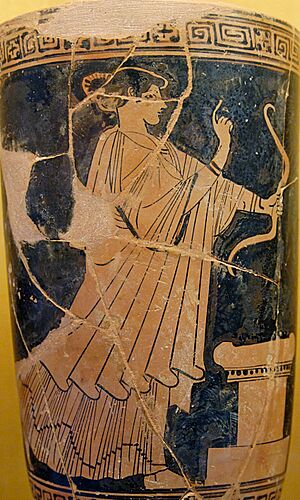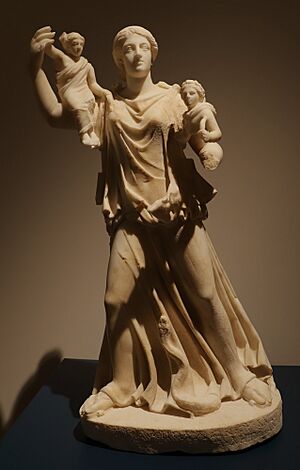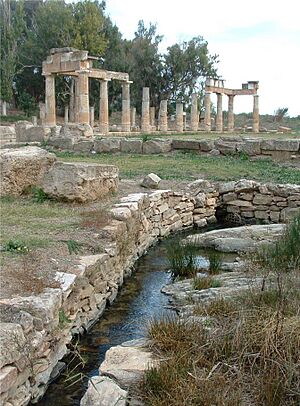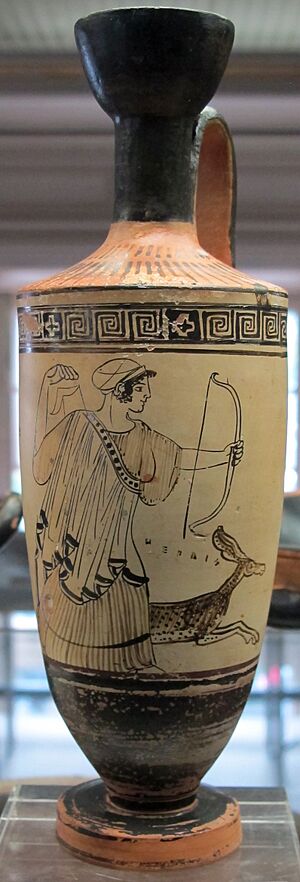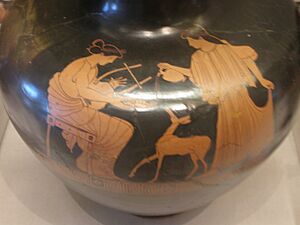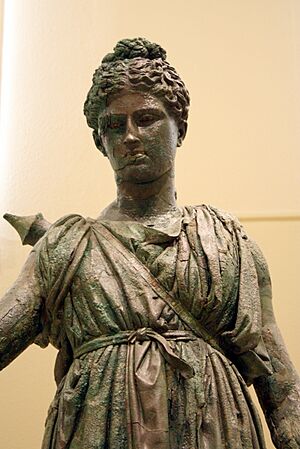Artemis facts for kids
Quick facts for kids Artemis |
|
|---|---|
| Goddess of nature, childbirth, wildlife, healing, the hunt, sudden death, animals, virginity, young women, and archery | |
| Member of the Twelve Olympians | |

|
|
| Abode | Mount Olympus |
| Planet | Moon |
| Animals | deer, serpent, dog, boar, goat, bear, quail, buzzard, guineafowl |
| Symbol | bow and arrows, crescent moon, animal pelts, spear, knives, torch, lyre, amaranth |
| Tree | cypress, palm, walnut |
| Mount | A golden chariot driven by four golden-horned deer |
| Personal information | |
| Born | Island of Delos, Greece |
| Parents | Zeus and Leto |
| Siblings | Apollo (twin), many paternal half-siblings |
| Roman equivalent | Diana |
In ancient Greek religion and mythology, Artemis (pronounced AR-tih-mis) is a powerful goddess. She is known for the hunt, the wilderness, and wild animals. She also protects nature, helps with childbirth, and cares for young children, especially girls. Artemis is one of the three main virgin goddesses, meaning she chose to remain unmarried. She was often seen roaming forests and mountains with her group of nymphs. The Roman goddess Diana is very similar to Artemis.
Artemis is the daughter of Zeus, the king of the gods, and Leto. She is the twin sister of Apollo. Many stories say that Zeus's wife, Hera, was upset about Leto. Hera made it impossible for Leto to give birth on any solid land. Only the island of Delos offered a safe place for Leto to have her children. In one story, Artemis was born first. She then helped her mother, Leto, deliver her twin brother, Apollo.
Artemis was a goddess who looked after children. She was a special protector of young girls. People also prayed to Artemis for healing and to avoid sickness, especially for women and children. She was believed to send both good health and illness. Artemis was one of the three main virgin goddesses, along with Athena and Hestia. She preferred to stay a maiden, and the goddess of love, Aphrodite, had no power over her.
In myths, Artemis is shown as a hunting goddess of the woods. She is always with her loyal group of nymphs. Her anger was well-known. For example, in the myth of Actaeon, a young hunter saw her bathing. Artemis was so angry that she turned him into a deer. His own hunting dogs then chased and ate him because they didn't recognize their master. In the story of Callisto, a girl was cast out of Artemis's group after she broke her promise to remain a maiden. This happened after she had a child with Zeus.
During the Trojan War, Artemis stopped the winds that were blowing the Greek ships. This trapped the Greek fleet in Aulis. King Agamemnon, the leader, had killed her sacred deer. Artemis demanded that Iphigenia, Agamemnon's young daughter, be sacrificed to make up for it. In most versions of the story, Artemis felt sorry for Iphigenia. She took the girl away at the last moment, leaving a deer in her place. In the war, Artemis supported the Trojans against the Greeks.
Artemis was one of the most respected gods in Ancient Greece. People worshipped her all over the ancient world. Her great temple at Ephesus was one of the Seven Wonders of the Ancient World. It was later destroyed by fire. Artemis's symbols include a bow and arrow, a quiver (for arrows), and hunting knives. The deer and the cypress tree were sacred to her. Her Roman equivalent, Diana, was especially worshipped in Rome and other parts of Italy.
Contents
Artemis: Goddess of the Wild
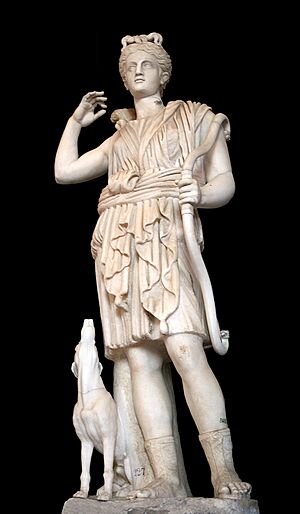
Artemis is seen as a goddess who loves hunting. She punishes those who upset her very strictly. Her anger shows how wild nature can be harsh to humans. The ancient Greek poet Homer called her "the mistress of animals." This title is seen in art from the Bronze Age, showing a woman with two animals. Artemis carries some traits from an older Minoan goddess whose history is now lost in myths.
Artemis was one of the most popular goddesses in Ancient Greece. Many Greek months were named after her, like Artemision. Festivals for the goddess were held in spring. In some places, she was seen as a goddess who could take the shape of a bear. The story of Kallisto in Arcadia is about Artemis in bear form. At festivals in Brauron and Piraeus, young girls dressed as she-bears before marriage.
The ancient Greeks called the image of a goddess with animals "Potnia Theron." This shows Artemis with a winged body between a panther and a deer. This special connection to animals made her different from other Greek gods. This is why Artemis was later linked to Hecate, who was a goddess of crossroads and queen of witches.
The festival of Laphria honored Artemis as the "mistress of the animals." During this festival, animals were thrown alive into a large fire. This festival was brought to Patras from Calydon. This links Artemis to the Greek heroine Atalanta, who represents freedom and independence.
In Homer's poems, Artemis is mainly the goddess of hunting. This was a very important sport in Mycenean Greece. She is often called "she who shoots arrows" or "she who delights in arrows." She is also called Artemis of the golden shafts or golden reins, showing her as a hunting goddess in her chariot. The Homeric Hymn 27 to Artemis describes her this way:
I sing of Artemis, whose shafts are of gold, who cheers on the hounds, the pure maiden, shooter of stags, who delights in archery, own sister to Apollo with the golden sword. Over the shadowy hills and windy peaks she draws her golden bow, rejoicing in the chase, and sends out grievous shafts. The tops of the high mountains tremble and the tangled wood echoes awesomely with the outcry of beasts: earthquakes and the sea also where fishes shoal.
The first Greeks in Arcadia believed Artemis was the first nymph. She was a goddess of free nature. She was independent and didn't need a partner. She hunted with her nymphs. This idea of freedom and women's skills is shown in many Greek myths.
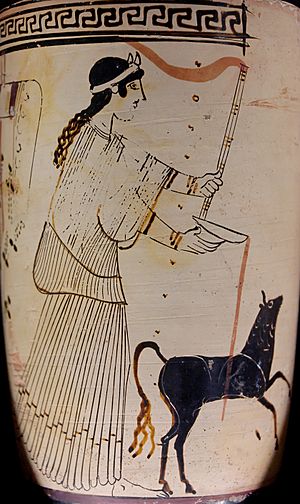
In Peloponnese, Artemis's temples were built near springs, rivers, and marshes. Artemis was closely linked to water, especially to Poseidon, the god of the waters. She was called Limnnaia or Limnatis (related to waters) and Potamia or Alphaea (related to rivers). In some places, she was a healing goddess for women.
Artemis leads the nymphs and hunts with them. Nymphs appeared during marriage festivals and were called upon by pregnant women. Artemis became a goddess of marriage and childbirth. She was worshipped as Eucleia in many cities. Women offered clothes to Artemis for a safe childbirth. She was also called Lochia and Lecho.
The Dorians saw Artemis mainly as a goddess of plants. She was worshipped in lively festivals with dances. The female dancers wore masks and were famous. This plant goddess was also linked to tree worship, with temples near holy trees.
Ancient Greeks believed that images of gods and goddesses had divine and magical powers. Artemis was worshipped as Tauria (the Tauric goddess), Aricina (in Italy), and Anaitis (in Lydia). In old songs, her image was found in bundles of leaves or dry sticks.
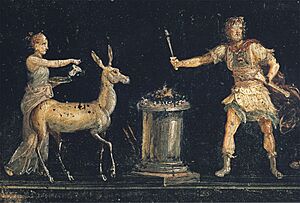
In European folklore, a wild hunter chases a magical woman who falls into water. In Greek myths, the hunter chases a female deer, and both disappear into the water. Artemis was worshipped as Saronia and Stymphalia in connection to these myths. The myth of a goddess being chased and falling into the sea is linked to the worship of Aphaea and Diktynna.
Artemis, carrying torches, was identified with Hecate. She was called Phosphoros and Selasphoros. In Athens and Tegea, she was worshipped as Artemis Kalliste, meaning "the most beautiful." Sometimes, the goddess had a name like an Amazon warrior, such as Lyceia or Molpadia. The Amazons showed the idea of freedom and women's independence.
Even though she was a virgin who avoided partners, many stories mention Artemis's beauty. In the Odyssey, Odysseus compared Nausicaa to Artemis's looks. Ancient poets noted Artemis's height and impressive presence. She stood taller and more striking than all the nymphs with her.
Her Many Names and Roles
Artemis's roots go back to an older Mycenean goddess of nature. This goddess was linked to birth and plants and had some connections to the underworld. The Mycenean goddess was also related to the Minoan mistress of animals. Artemis carries traits from this older Minoan form. The first Greeks in Arcadia believed Artemis was the first nymph, a goddess of free nature. She was a great goddess, and her temples were built near springs, marshes, and rivers where nymphs lived. Pregnant women asked nymphs for help. Artemis became the goddess of marriage and childbirth.
Artemis sometimes shows a wild and darker side. She can bring sudden death with her arrows. However, she also represents "free nature." The Dorians later came to the area and saw her mostly as a plant goddess. She was worshipped in lively festivals with dances. The female dancers often wore masks. Artemis's great popularity comes from the Greek belief in freedom. She is mainly the goddess of women and children. The goddess of free nature is independent and unmarried. Artemis is often shown carrying a torch and was sometimes identified with Hecate. Like other Greek gods, she had many other names. These names showed her different roles and aspects.
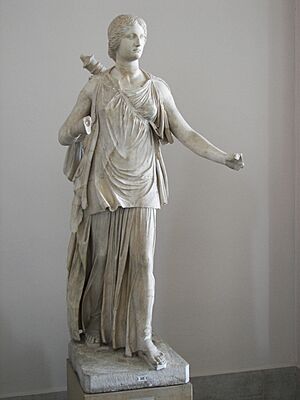
- Aeginaea: Likely a huntress or javelin thrower, worshipped at Sparta.
- Aetole: From Aetolia at Nafpaktos. A statue showed her throwing a javelin.
- Agoraea: Guardian of public meetings in Athens. She protected people's gatherings in the agora.
- Agrotera: The huntress of wild woods, mentioned in the Iliad. People believed she first hunted at Agrae in Athens. A "slaughter sacrifice" was made to her before battles.
- Alphaea: Worshipped in Elis. She had a yearly festival at Olympia. Girls danced wearing masks at her festival.
- Amarynthia or Amarysia: Had a famous temple near Eretria. She was linked to animals and was a healing goddess for women.
- Amphipyros: Meaning "with fire at each end," a rare name for Artemis carrying a torch in each hand.
- Anaitis: Worshipped in Lydia. Her image was believed to have divine powers.
- Angelos: Meaning "messenger," a title for Artemis at Syracuse in Sicily.
- Apanchomene: in Arcadia. She was a plant goddess linked to tree worship.
- Aphaea or Apha: Meaning "unseen" or "disappeared," a goddess at Aegina. She is identified with Britomartis.
- Aricina: From the town Aricia in Latium, Italy. She was linked to Artemis Tauria.
- Ariste: Meaning "the best," a goddess for women. Pausanias described statues of "Ariste" and "Kalliste" in Athens.
- Aristobule: Meaning "the best advisor," at Athens.
- Astrateia: Meaning "she that stops an invasion," at Pyrrichos in Laconia. A wooden statue was dedicated to her for stopping an Amazon invasion.
- Basileie: Worshipped in Thrace and Paeonia. Women offered wheat stalks to her.
- Brauronia: Worshipped at Brauron in Attica. Young girls dressed as bears and served the goddess before marriage.
- Boulaia: Of the council, in Athens.
- Boulephoros: Counselling, advising, at Miletus.
- Caryatis: The "lady of the nut-tree," at Caryae. Artemis was strongly linked to nymphs. Young girls performed the Caryatis dance.
- Cedreatis: Near Orchomenus in Arcadia. A statue was placed on a holy cedar tree.
- Chesias: From a river name at Samos.
- Chitonia: Wearing a loose tunic, at Syracuse in Sicily, as a hunting goddess.
- Chrisilakatos: Of the golden arrow, in Homer's Iliad. She could bring sudden death with her arrows.
- Chrisinios: Of the golden reins, as a hunting goddess in her chariot.
- Coryphaea: Of the peak, at Epidaurus in Argolis.
- Cnagia: Near Sparta. A legend says a priestess brought her statue from Crete.
- Cynthia: As goddess of the moon, from her birthplace on Mount Cynthos at Delos.
- Daphnaea: As goddess of plants. Her name comes from the laurel branch.
- Delia: The female form of Apollo Delios.
- Delphinia: The female form of Apollo Delphinios.
- Dereatis: At Sparta. Dancers performed a lively dance.
- Diktynna: From Mount Dikti, identified with the Minoan goddess Britomartis.
- Eileithyia: Goddess of childbirth in Boeotia and other places.
- Elaphia: Goddess of hunting (deer).
- Elaphebolos: Shooter of deer, with a festival called "Elaphebolia."
- Ephesia: Worshipped at Ephesus. She was a goddess of free nature.
- Eucleia: As a goddess of marriage. Young people made sacrifices to her before marriage.
- Eupraxis: Fine acting. She is shown holding a torch and an offering.
- Eurynome: Wide ruling, at Phigalia in Arcadia. Her wooden statue had a fish-like lower body.
- Hagemo or Hegemone: Leader, as the leader of the nymphs.
- Heleia: Related to marshes or meadows in Arcadia, Messenia, and Kos.
- Hemeresia: The soothing goddess worshipped at Lusoi.
- Heurippa: Horse finder, at Pheneus in Arcadia.
- Hymnia: At Orchomenos in Boeotia. She was a goddess of dance and songs.
- Iakinthotrophos: Nurse of Hyacinthos at Knidos.
- Imbrasia: From a river name at Samos.
- Iocheaira: Shooter of arrows, as a hunting goddess.
- Issora or Isora: At Sparta.
- Kalliste: The most beautiful, another form of Artemis as a bear in Arcadia.
- Keladeini: Echoing chasing (noisy) in Homer's Iliad.
- Kithone: As a goddess of childbirth at Millet.
- Kolainis: Related to animals at Euboea and Attica.
- Kolias: In a women's cult. Men were not allowed.
- Kondyleatis: Named after a village. A legend says boys were killed for tying a rope around her image.
- Kordaka: In Elis. Dancers performed a lively dance.
- Korythalia: From "laurel May-branch," as a plant goddess at Sparta.
- Kourotrophos: Protector of children.
- Laphria: The mistress of animals, in many cults.
- Lecho: Protector of women in childbirth.
- Leukophryene: From the city Leucophrys in Magnesia.
- Limnaia: Of the marsh, at Sparta.
- Limnatis: Of the marsh and lake, at Patras.
- Lochia: As goddess of childbirth and midwifery.
- Lousia: Bather or purifier, as a healing goddess at Lusoi.
- Lyaia: At Syracuse in Sicily.
- Lyceia: Of the wolf or with a wolf-skin helmet, at Troezen.
- Lycoatis: With a bronze statue at Lycoa in Arcadia.
- Lygodesma: Willow bound, at Sparta.
- Melissa: Bee or beauty of nature, as a moon goddess.
- Molpadia: Singer of divine songs, a rare name for Artemis as a goddess of dances.
- Munichia: In a cult at Piraeus, related to the arkteia.
- Mysia: With a temple on the road from Sparta to Arcadia.
- Oenoatis: From the city Oenoe in Argolis.
- Orthia: Upright, with a famous festival at Sparta.
- Paidotrophos: Protector of children at Corone.
- Peitho: Persuasion, at Argos.
- Pergaia: Worshipped at Pamphylia.
- Pheraia: From the city Pherai.
- Phakelitis: Of the bundle, at Tyndaris in Sicily.
- Phoebe: Bright, as a moon goddess.
- Phosphoros: Carrier of light.
- Polo: In Thasos.
- Potamia: Of the river, at Ortygia in Sicily.
- Potnia Theron: Mistress of the animals.
- Pythia: As a goddess worshipped at Delphi.
- Saronia: Of Saron, at Troezen.
- Selasphoros: Carrier of light, flame, as a moon-goddess.
- Soteira (Kore Soteira): Kore saviour, at Phigalia.
- Stymphalia: Of Stymphalus.
- Tauria or Tauro: The Tauric goddess.
- Tauropolos: Usually interpreted as hunting bull goddess.
- Thermia: As a healer goddess at Lousoi.
- Toxia or Toxitis: Bowstring in torsion, as goddess of hunting.
- Triclaria: At Patras.
- Issoria (Ἰσσωρία): From her shrine at Mount Issorion in Laconia.
Famous Myths About Artemis
Greek mythology has different stories about how Artemis and her twin brother, Apollo, were born. However, all stories agree that their parents were Zeus and Leto. In some tales, they were born at the same time. In others, Artemis was born first.
The oldest story about Leto giving birth only focuses on Apollo. It doesn't even say they were twins. Later, the poet Pindar wrote about a single pregnancy. The earliest poets, Homer and Hesiod, confirmed they were full siblings but didn't call them twins.
According to Callimachus, Hera was angry at Zeus for having children with Leto. So, Hera forbade Leto from giving birth on any land or island. But the island of Delos helped Leto. Some say this made the floating island stay in one place. Other stories say they were born on Ortygia.
Myths also differ on who was born first. Most stories say Artemis was born first. She then became her mother's helper when Apollo was born. One writer said Artemis was born first because it was night, and she represents the Moon. Then came day, which Apollo represents. But Pindar wrote that both twins shone like the Sun when they were born.
After their difficult birth, Leto took the babies to Lycia. There, she tried to drink from a spring and bathe the babies. But local farmers tried to stop them by stirring up the mud. Angry that they refused to help a tired mother and thirsty babies, Leto turned them into frogs. They were then stuck swimming and hopping around the spring forever.
Artemis and Men
Artemis and Apollo are credited with inventing archery. When the giant Tityos tried to harm Leto, she called her children for help. Even though they were young, the twins quickly shot arrows at Tityos, killing him. For this, Tityos was sent to Tartarus, a dark underworld. There, two vultures ate his liver every day.
The giant twin sons of Poseidon, Otos and Ephialtes, grew very quickly. They were skilled hunters and could only be killed by each other. They boasted they would kidnap Artemis and Hera. The gods were scared, but Artemis tricked them. She made a fine deer appear between them. In another version, she turned into a deer. The giants threw their spears and accidentally killed each other.
According to Diodorus Siculus, Britomartis was a nymph and huntress who used nets. She was a beloved friend of Artemis. Minos, king of Crete, chased Britomartis for nine months. To escape, she jumped into the sea and landed in fishermen's nets. Artemis rescued her and made her a goddess.

Eurystheus ordered Heracles to catch the Ceryneian Hind. This was a female deer with golden antlers and bronze hooves, sacred to Artemis. Eurystheus hoped Artemis would punish Heracles. The hind was once Taygete, a friend of Artemis, whom Zeus had chased. Artemis saved Taygete by turning her into the hind. When Heracles returned with the hind, he met Artemis and Apollo. He begged for forgiveness, explaining it was part of his tasks. He promised to return the hind to the wild. Artemis believed him and forgave him, ruining Eurystheus's plan.
The river god Alpheus loved Artemis. When he realized he couldn't win her heart, he tried to capture her. When Artemis and her friends went to Alpheus, she suspected his plan. She covered her face with mud so he wouldn't recognize her. In another story, Alpheus tried to harm Artemis's friend Arethusa. Artemis felt sorry for Arethusa and saved her by turning her into a spring.
According to one writer, Siproites was a Cretan man who saw Artemis bathing. Artemis turned him into a woman. She also turned a man named Calydon into stone for seeing her bathe.
Daphnis, a young son of Hermes, became a follower of Artemis. He often hunted with her and entertained her with his songs and panpipes. Artemis taught a man named Scamandrius to be a great archer. He became excellent with a bow and arrow.
Bouphagos, a son of the Titan Iapetus, thought about harming Artemis. Reading his thoughts, Artemis struck him down. Broteas was a famous hunter who refused to honor Artemis. He boasted that nothing could harm him, not even fire. Artemis made him go mad, and he walked into a fire, ending his life.
Actaeon and the Deer
Many versions of the Actaeon myth exist. The main idea is that the great hunter Actaeon was turned into a stag by Artemis for something he did. Then, his own hunting dogs killed him because they didn't recognize him. Sometimes, the dogs are said to be Artemis's own hounds.
The stories differ on what Actaeon did wrong. Sometimes, he simply saw the virgin goddess bathing. Other times, he boasted he was a better hunter than her. Or he was a rival of Zeus for someone's affection. The most common versions say he saw Artemis bathing.
One likely original version says Actaeon was Artemis's hunting friend. He saw her bathing in her sacred spring and tried to force himself on her. For this disrespect, he was turned into a stag and eaten by his own dogs. However, in some stories, Actaeon was a stranger who just happened to find Artemis.
Early stories mention that "the dogs destroyed their master." Later, writers added that Actaeon was turned into a deer. Some say Artemis turned him into a deer and made his dogs go wild so they would kill him. After Actaeon died, a wise centaur named Chiron built a statue of Actaeon to comfort his grieving dogs.
The Roman poet Ovid tells a version where Actaeon, after hunting, found Artemis and her nymphs bathing. The nymphs rushed to cover Artemis. Artemis splashed water on Actaeon, saying he could tell everyone what he saw, as long as he could still speak. Immediately, he turned into a deer and ran away. But his fifty hunting dogs chased and ate him, not knowing it was their master.
Niobe's Pride
The story of Niobe, queen of Thebes, is very old. Niobe boasted that she was better than Leto because she had many children (usually twelve or fourteen), while Leto only had two, Artemis and Apollo. Niobe also made fun of Apollo's looks and Artemis's strong appearance. Leto became very angry and told her children to get revenge.
Apollo and Artemis quickly went to Thebes. While Niobe's sons were hunting, Apollo shot all seven with his silver bow. Their bodies were brought to the palace. Niobe cried but still boasted that she was better than Leto because she still had her daughters.
Then, Artemis began shooting Niobe's daughters one by one. As Niobe begged for her youngest child to be spared, Artemis killed that last one. Niobe cried bitterly and was turned into a rock. Her husband, Amphion, died by his own hand. In some versions, Apollo and Artemis spared one son and one daughter because they prayed to Leto.
Orion, the Hunter
Orion was Artemis's hunting friend. After searching for someone else, Orion met Artemis and her mother Leto and joined them in hunting. He was a great hunter and boasted that he would kill every animal on Earth. Gaia, the Earth, was not happy about this. She sent a giant scorpion to sting him. Artemis then placed him among the stars as the constellation Orion. In one story, Orion died after pushing Leto out of the scorpion's way.
In another version, Orion tried to harm one of Artemis's followers, and Artemis killed him. Other writers say Artemis killed him for trying to harm her or her friends.
One story says Artemis fell in love with Orion, which was unusual for her. She wanted to marry him, and her brother Apollo couldn't change her mind. Apollo then tricked Artemis. While Orion was swimming far away, Apollo pointed to him (a tiny spot) and bet Artemis couldn't hit it. Eager to prove her skill, Artemis shot Orion, killing him. She then placed him among the stars.
In Homer's Iliad, the goddess of dawn, Eos, fell in love with Orion. This angered the gods, who didn't like goddesses loving mortal men. So, Artemis shot and killed him on the island of Ortygia.
Callisto's Transformation

Callisto, daughter of King Lycaon of Arcadia, was one of Artemis's hunting companions. As a friend of Artemis, she promised to remain a maiden.
According to one poem, Zeus appeared to Callisto and she became pregnant. She hid her pregnancy for a while, but it was discovered while she was bathing. Enraged, Artemis turned Callisto into a bear. In this form, she gave birth to her son, Arcas. Both were captured by shepherds and given to Lycaon. Later, Callisto entered a forbidden sanctuary of Zeus and was hunted by the Arcadians, including her son. Just as she was about to be killed, Zeus saved her by placing her in the heavens as a bear constellation.
Other versions say Zeus tricked Callisto by pretending to be Artemis. When Artemis found out Callisto was pregnant, she turned her into a bear. In some stories, Hera, Zeus's wife, turned Callisto into a bear. Artemis then killed the bear while hunting. Zeus then placed Callisto among the stars.
Ovid tells a slightly different story. Zeus tricked Callisto by pretending to be Artemis. Callisto was then cast out of the huntresses' group and gave birth to Arcas as a human. Later, Hera turned her into a bear. When Arcas, now grown, was hunting, he almost killed his mother. Zeus saved her by placing her in the heavens.
Another version says Zeus harmed Callisto, either disguised as Artemis or Apollo. He then turned her into a bear to hide it from Hera. Artemis then shot the bear, either because Hera asked her to, or because she was angry that Callisto broke her promise. After Callisto died, Zeus made her a constellation and gave her child, Arcas, to another goddess to raise.
Minor Myths
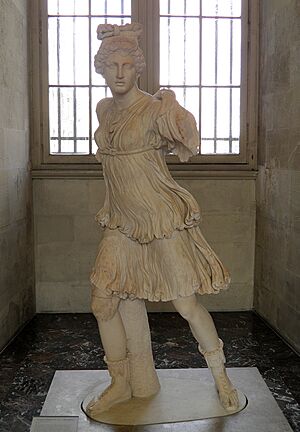
Artemis helped Heracles kill a giant named Gration during a battle between gods and giants. When the monster Typhon attacked Olympus, all the gods except Zeus turned into animals and fled to Egypt. Artemis became a cat, as she was linked to the Egyptian cat goddess Bastet.
Artemis saved the baby Atalanta from freezing to death after her father left her. She sent a female bear to nurse the baby. Hunters then raised Atalanta, and she grew up to be like Artemis. In some stories, Artemis later sent a bear to attack Atalanta because others said Atalanta was a better hunter. Atalanta also took part in the Calydonian boar hunt, which Artemis had sent to destroy Calydon. This was because King Oeneus had forgotten to honor her during harvest sacrifices. Atalanta was the first to wound the boar and won its hide as a prize. After the death of Meleager, Oeneus's son, Artemis turned his grieving sisters into guineafowl, which she favored.
Cyrene was a fierce huntress from Thessaly and a friend of Artemis. Artemis gave her two hunting dogs. With these dogs, Cyrene won a prize in games. When a monster lion terrorized a city, Apollo brought Cyrene to get rid of it. After she killed the lion, he made her the new ruler of the land. In some versions, she became a nymph so she could hunt with Artemis forever.
In one story, Artemis and her mother Leto stood before Zeus with tears. Apollo asked Zeus to free Prometheus, a god who had stolen fire for humans and was being punished. Zeus agreed and told Heracles to free Prometheus.
In some stories about Adonis, Artemis sent a wild boar to kill him. This was punishment for him boasting he was a better hunter than her. In other versions, Artemis killed Adonis for revenge. Later myths say Adonis was a favorite of Aphrodite, who had caused the death of Hippolytus, a hunter of Artemis. So, Artemis killed Adonis to avenge Hippolytus.
Two of Artemis's hunting companions, Rhodopis and Euthynicus, had promised to remain pure and devoted to her. But they fell in love in a cave. Artemis turned Rhodopis into a fountain in that cave as punishment. They had fallen in love because Eros, the god of love, shot them with his arrows. His mother, Aphrodite, had ordered this because they rejected love and marriage.
In one story, Aura, a friend of Artemis, said Artemis's body was too womanly. She boasted her own body was better and a true sign of her purity. Angry, Artemis asked Nemesis for help. Nemesis arranged for Eros to make Dionysus fall in love with Aura. Dionysus harmed her while she was unconscious. She became a wild killer. When she had twin sons, she ate one. Artemis saved the other, Iacchus.
Chione was a princess who was loved by two gods, Hermes and Apollo. She boasted she was more beautiful than Artemis because two gods loved her. Artemis was furious and killed Chione with an arrow. Some stories say Apollo and Hermes protected her from Artemis's anger.
Polyphonte wanted a free, pure life with Artemis, not marriage. As punishment, Aphrodite cursed her, making her have children with a bear. Artemis was disgusted and sent wild animals after her. Polyphonte fled home. Her children were wild. Zeus hated them. The whole family was turned into birds that brought bad luck.
Coronis was a princess who became Apollo's lover and got pregnant. While Apollo was away, Coronis started a relationship with a mortal man. When Apollo found out, he sent Artemis to kill Coronis. Or Artemis killed Coronis on her own to avenge her brother. The unborn child, Asclepius, was saved from his dead mother's womb.
When Queen Echemeia of Kos stopped worshipping Artemis, Artemis shot her with an arrow. Persephone then took Euthemia, still alive, to the Underworld.
Artemis in the Trojan War
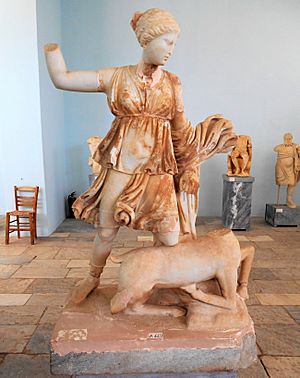
Artemis may have supported Troy because her brother Apollo was the city's patron god. She was also widely worshipped in western Anatolia. Artemis played a big role in the war. Like Leto and Apollo, she sided with the Trojans. In the Iliad, Artemis, in her chariot, kills the daughter of a hero. At the start of the Greek journey to Troy, Artemis punished Agamemnon. He had killed a sacred stag in her sacred grove and boasted he was a better hunter than her.
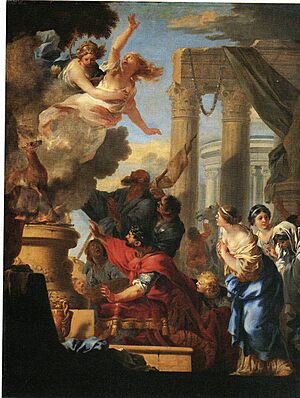
When the Greek fleet was getting ready at Aulis to go to Troy for the Trojan War, Artemis stopped the winds. A prophet wrongly told Agamemnon that the only way to please Artemis was to sacrifice his daughter Iphigenia. In some stories, Artemis took Iphigenia from the altar and put a deer in her place. In others, Artemis allowed Iphigenia to be sacrificed. In versions where Iphigenia survived, she was taken to Tauris and became a priestess there.
Aeneas was also helped by Artemis, Leto, and Apollo. Apollo found him wounded and took him to heaven. There, the three gods secretly healed him.
During a battle between the gods, Artemis faced Hera. An old text says they represented the Moon versus the air around the Earth. Artemis scolded Apollo for not fighting. An angry Hera then yelled at Artemis for daring to fight her. Hera grabbed Artemis's wrists and beat her with her own bow. Crying, Artemis left her bow and arrows and ran to Olympus to cry at Zeus's knees. Her mother Leto picked up her bow and arrows and followed her.
How People Worshipped Artemis
Artemis, the goddess of forests and hills, was worshipped all over ancient Greece. Her most famous places of worship were on the island of Delos (where she was born), in Attica at Brauron and Mounikhia (near Piraeus), and in Sparta. She was often shown in art in a forest, carrying a bow and arrows, with a deer.
The ancient Spartans would sacrifice to her as one of their patron goddesses before starting a new military campaign.
Athenian festivals honoring Artemis included Elaphebolia, Mounikhia, Kharisteria, and Brauronia. The festival of Artemis Orthia was celebrated in Sparta.
Young Athenian girls, before they reached puberty, were sent to the sanctuary of Artemis at Brauron to serve the Goddess for one year. During this time, they were called arktoi, meaning "little she-bears."
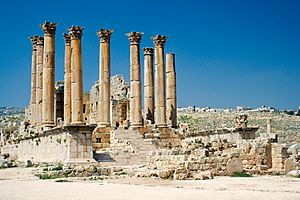
A myth explains this service. A bear used to visit Brauron, and people fed it, making it tame. One day, a girl teased the bear. In some stories, it killed her; in others, it clawed out her eyes. The girl's brothers killed the bear, and Artemis was furious. She demanded that young girls "act the bear" at her sanctuary to make up for the bear's death.
Artemis was worshipped as one of the main goddesses of childbirth and midwifery. It was common to dedicate clothes to her sanctuaries after a successful birth. Artemis could also be feared by pregnant women, as deaths during childbirth were sometimes blamed on her.

It was a good sign if Artemis appeared in the dreams of hunters and pregnant women. But seeing a naked Artemis was a bad sign. She helped her mother give birth to her twin. Older stories say another goddess, Eileithyia, had to arrive for Leto to give birth.
Even though she was known as a hunting goddess, Artemis was also linked to dancing, music, and song, like her brother Apollo. She is often seen singing and dancing with her nymphs. In Sparta, girls of marriageable age performed songs in her honor. An old Greek saying was, "For where did Artemis not dance?", showing her connection to dancing and celebrations.
During the Classical period in Athens, she was identified with Hecate. Artemis also took on traits of Caryatis. There was a women's cult in Cyzicus that worshipped Artemis.
Festivals for Artemis
Artemis was born on the sixth day of the month Thargelion (around May), which was sacred to her. Apollo's birthday was on the seventh day of the same month. Artemis was worshipped in many festivals across Greece, the islands, Asia Minor, and southern Italy. Most of these festivals were celebrated in spring.
- Athens: The festival Elaphebolia was celebrated on the sixth day of the month Elaphebolion. The name is linked to "deer," and Artemis is the Deer Huntress. Cakes shaped like stags were offered to her.
- Brauron: The festival was known for the arkteia. Girls, aged five to ten, dressed in saffron robes and pretended to be bears. This was to calm the goddess after her bear was killed.
- Piraeus: The festival of Artemis Munichia was celebrated on the 6th or 16th day of the month Munichion. Young girls dressed as bears, similar to the Brauronia. This festival remembered the Greek fleet's victory over the Persians at Salamis.
- Athens: Artemis had a related cult of Brauronia near the Acropolis.
- Agrae: A district of Athens with a temple of Artemis-Agrotera (huntress). On the 6th day of the month Boedromion, a procession took many goats to the temple. They were sacrificed to honor the victory at the Battle of Marathon. This festival was called "Charisteria," or Athenian "Thanksgiving."
- Myrrhinus: A village near Merenda. There was a cult of Kolainis, identified with Artemis Amarysia.
- Athmonia: A village near Marousi. The festival of Artemis Amarysia was as grand as the one in Euboea.
- Halae Araphenides: A village near Brauron. The festival Tauropolia honored Artemis Tauropolos.
- Erchia: A district of Athens. A festival was held on the 16th day of the month Metageitnion. Sacrifices were offered to Artemis and Hekate.
- Hyampolis in Phocis: During an attack, the Phocians gathered their women, children, and belongings to burn them if they lost. They won a great victory instead. Each year, they celebrated with the festival Elaphebolia-Laphria for Artemis. Offerings were burned in a fire, remembering the battle.
- Delphi in Phocis: The festival Laphria was celebrated. The cult of Artemis Laphria was brought by priests who may have been from Crete.
- Delphi in Phocis: The festival Eucleia honored Artemis as a goddess of marriage.
- Tithorea in Ancient Phocis: A festival for Artemis Laphria was reformed into a festival for Isis.
- Erineos in Doris: Festival of Artemis Laphria.
- Antikyra in Phocis: Cult of Artemis-Diktynaia, a popular goddess.
- Thebes in Boeotia: Before marriage, brides and grooms made a sacrifice to Artemis-Eucleia.
- Amarynthos in Euboia: Festival of Artemis Amarysia. Animals were sacrificed.
- Aulis in Boeotia: Sacrificial animals were offered to the goddess.
- Calydon in Aetolia: Considered the origin of the cult of Artemis Laphria at Patras.
- Nafpaktos in Aetolia: Cult of Artemis Laphria.
- Acarnania: Cult of Artemis-Agrotera (huntress) in a society of hunters.
- Patras in Achaea: The great festival Laphria was celebrated. Birds, deer, and other animals were thrown alive into a large fire.
- Patras: The Ionians celebrated the annual festival of Artemis Triclaria. Human sacrifices were once part of this, but a new god, Dionysus, ended them.
- Corinth: The festival Eucleia honored Artemis.
- Aigeira in Achaea: Festival of Artemis Agrotera (huntress).
- Sparta: Festival of Artemis-Orthia. Women performed round dances. The prize for competitions was an iron sickle, showing Orthia was a plant goddess.
- Sparta on the road to Amyklai: Artemis-Korythalia was a plant goddess. Women performed lively dances. Nurses brought infants to her temple.
- Messene near Laconia: Festival of Artemis Limnatis (of the lake). Celebrated with cymbals and dances.
- Dereion on Taygetos in Laconia: Cult of Artemis -Dereatis. The festival had hymns and lively dances.
- Epidauros Limera in Laconia: Cult of Artemis-Limnatis.
- Caryae on the borders between Laconia and Arcadia: Festival of Artemis-Caryatis, a plant goddess. Women performed an ecstatic dance.
- Boiai in Laconia: Cult of Artemis-Soteira (savior).
- Gytheion in Laconia: Cult of Artemis Laphria.
- Elis: People celebrated their victory near the temple of Artemis-Kordaka with a peculiar dance.
- Elis: Festival of Artemis-Elaphia (of the deer).
- Letrinoi in Elis: Festival of Artemis Alpheaia. Girls wearing masks performed dances.
- Olympia in Elis: Annual festival of Artemis Alpheaia.
- Olympia in Elis: Annual festival of Artemis Elaphia.
- Olympia in Elis: Annual festival of Artemis Daphnaia (of the laurel-branch), as a plant goddess.
- Hypsus in Arcadia: Annual festival of Artemis-Diktynna.
- Hypsus: Annual festival of Artemis Daphnaia.
- Stymphalus in Arcadia: Festival of Artemis-Stymphalia.
- Orchomenus, in Arcadia: A sanctuary was built for Artemis Hymnia where her festival was celebrated.
- Tegea in Arcadia: Cult of Artemis-Limnatis (of the lake).
- Phigalia in Arcadia: A sanctuary of Artemis-Soteira (Savior) was built after a battle.
- Troizen in Argolis: Festival of Artemis-Saronia.
- Aegae, in Macedonia: Eucleia had a shrine. She is linked to Artemis-Eucleia, the goddess of marriage.
- Apollonia of Chalcidice: The festival Elaphebolia was celebrated for Artemis.
- Icaria: The Tauropolion, a temple of Artemis Tauropolos, was built.
- Cephalonia: Cult of Artemis-Laphria, linked to the legend of Britomartis.
- Corcyra: Cult of Artemis-Laphria.
- Ephesus in Ionia: The great festival Artemisia was celebrated. The temple's wealth showed Artemis Ephesia's power.
- Perga in Ionia: Famous festival of Artemis-Pergaia.
- Iasos in Caria: The festival Elaphebolia was celebrated for Artemis.
- Byzantion: Festival of Artemis-Eucleia.
- Syracuse in Sicily: The festival of Artemis Chitonia had a special dance and flute music.
- Syracuse in Sicily: Festival of Artemis-Lyaia. Men from the countryside came dressed in rustic clothes, carrying deer antlers and shepherd's staffs. They sang satirical songs.
- Tauromenion in Sicily: Festival of Artemis-Eucleia.
- Festival of Artemis-Korythalia: Male dancers wore wooden masks.
Symbols of Artemis
Artemis is often shown with symbols that represent her powers and roles.
Chariots
Homer calls Artemis "of the golden reins" to describe her hunting chariot. At the festival of Laphria at Delphi, the priestess rode in a chariot covered with deer skin.
Spears, Nets, and Lyre
Artemis is rarely shown with a hunting spear. In her worship in Aetolia, Artemis Aetole was depicted with a hunting spear or javelin. She is also sometimes shown with a fishing spear, linked to her role as a patron goddess of fishing. This connects her to Diktynna (Britomartis). As a goddess of maiden dances and songs, Artemis is often shown with a lyre in ancient art.
Deer
Deer were the only animals sacred to Artemis herself. When she saw a deer larger than a bull with shining horns, she loved these creatures and made them sacred. Deer were also the first animals she caught. She captured five golden-horned deer and harnessed them to her chariot. At Lycosura in Arcadia, Artemis is shown holding a snake and a torch, dressed in deer skin. At the festival of Laphria at Delphi, the priestess rode in a chariot covered with deer skin.
The third task of Heracles was to chase and catch the terrible Ceryneian Hind. This hind was a female deer with golden antlers and bronze hooves, sacred to Artemis. Heracles begged Artemis for forgiveness and promised to return it alive. Artemis forgave him but was angry at Eurystheus.
Hunting Dog
In one story, Artemis got her hunting dogs from Pan in the forest of Arcadia. Pan gave Artemis two black-and-white dogs, three reddish ones, and one spotted one. These dogs could even hunt lions. Pan also gave Artemis seven of the best Arcadian female dogs, but Artemis only took seven dogs hunting at a time. In the earliest images of Artemis at Lycosura, a hunting dog lay by her side.
Bear
In an old cult, Artemis was seen as a bear. Kallisto was turned into a bear, and she is a form of Artemis with an animal shape. In the worship of Artemis at Brauron and Piraeus Munichia, young girls dressed as she-bears in a ritual and served the goddess before marriage.
A myth tries to explain the origin of the "bear ritual." Every year, a girl aged five to ten was sent to Artemis's temple at Brauron. A bear was tamed by Artemis and brought to Athens. People played with it until one day, some girls poked it, and it attacked them. A brother of one of the girls killed the bear, so Artemis sent a plague in revenge. The Athenians asked an oracle how to stop the plague. The oracle said that to pay for the bear's death, no Athenian maiden could marry until she had served Artemis in her temple (played the bear for the goddess).
In a legend of the Munichia cult, if someone killed a bear, they had to sacrifice their daughter in the sanctuary. A man named Embaros dressed his daughter like a bear and hid her. He sacrificed a goat instead of his daughter.
Boar
The boar is a favorite animal of hunters and is hard to tame. In honor of Artemis's skill, they sacrificed it to her. Oeneus and Adonis were both killed by Artemis's boar. In The Odyssey, she comes down from a peak and travels along the ridges of Mount Erymanthos, which was sacred to the "Mistress of the animals." When the goddess was angry, she would send the terrible Erymanthian boar to destroy farmers' fields. Heracles managed to kill this creature during his Twelve Labors.
In one story, the Calydonian boar terrorized the land of Calydon because Artemis was offended. The Calydonian boar hunt is one of the great heroic adventures in Greek legend. Many famous Greek heroes, including Meleager and Atalanta, took part. The fierce huntress Atalanta, allied with Artemis, was the first to wound the Calydonian boar.
Ovid describes the boar:
- A dreadful boar.—His burning, bloodshot eyes
- seemed coals of living fire, and his rough neck
- was knotted with stiff muscles, and thick-set
- with bristles like sharp spikes. A seething froth
- dripped on his shoulders, and his tusks
- were like the spoils of Ind [India]. Discordant roars
- reverberated from his hideous jaws;
- and lightning—belched forth from his horrid throat—
- scorched the green fields.
- — Ovid, Metamorphoses 8.284–289 (Brookes More translation)
Guinea Fowl
Artemis felt sorry for the princesses of Calydon, the Meleagrids, as they mourned their lost brother, Meleager. So, she turned them into Guinea fowl to be her favorite animals.
Bee
The bee, a symbol of plenty, was linked to Artemis Ephesia. Bees appear on the goddess's statue. The priestesses of the goddess were called 'Melissa' ('Bee'), possibly a later addition to her worship. The bee was also linked to the Cretan tradition, where Artemis was called 'Britomartis', a word possibly related to 'melissa'.
Buzzard Hawk
Hawks were favored birds of many gods, including Artemis.
Bull
Artemis is sometimes linked to a mythical bull-goddess in a foreign cult in Greece. This cult can be found in Halae Araphenides in Attica.
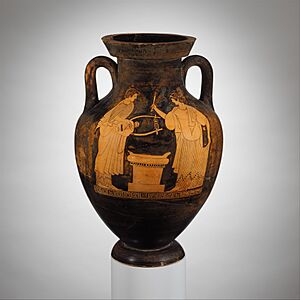
Euripides connects her worship with Tauris (bull) and the myth of Iphigenia at Brauron. It was believed that the goddess's image was brought from Tauris to Brauron, Sparta, or Aricia.
Torch
Artemis is often shown holding one or two torches. There is no clear reason for this. The goddess's character in Arcadia seems to be original. At Acacesium, Artemis Hegemone (the leader) is shown holding two torches. At Lycosura, the goddess is shown holding a snake and a torch, with a hunting dog by her side. Sophocles calls Artemis "Elaphebolos (deer slayer), Amphipyros (with a fire in each end)," referring to the yearly fire of the festival Laphria at Delphi. This also refers to the twin fires on the two peaks of Mount Parnassus above Delphi. On a relief from Sicily, the goddess is shown holding a torch and an offering. The torch was used to light the fire on the altar.
Artemis in Art
During the Bronze Age, the "mistress of the animals" is usually shown between two lions, wearing a special crown. The oldest images of Artemis in Greek Archaic art (around 550 BCE) show her as Potnia Theron ("Queen of the Beasts"). She is a winged goddess holding a stag and a lioness, or sometimes two lions. This winged Artemis was seen in offerings as Artemis Orthia, near Sparta.
In Greek classical art, she is usually shown as a young, tall, and slim maiden huntress. She wears a short skirt and hunting boots, with a quiver, a golden or silver bow, and arrows. Often, she is in a shooting pose and is with a hunting dog or a stag. When shown as a moon goddess, Artemis wore a long robe and sometimes a veil. Her darker side is seen in some vase paintings, where she brings death with her arrows to young maidens and women, like the daughters of Niobe.
Artemis was sometimes shown in Classical art with a crescent moon crown, like the goddess Luna. In 2007, a Roman bronze sculpture of Artemis and the Stag was sold for $25.5 million.
Images for kids
-
Nicolas Poussin (1658) "Landscape with blind Orion seeking the sun". Metropolitan Museum of Arts, Manhattan, New York.
Legacy
In Astronomy
- 105 Artemis is an asteroid discovered in 1868.
- Artemis (crater) is a tiny crater on the Moon, named in 2010.
- Artemis Chasma is a nearly circular crack on the planet Venus, described in 1980.
- Artemis Corona is an oval feature mostly inside the Artemis Chasma, also described in 1980.
- ArTeMiS is an acronym for a large camera used in submillimeter range. It was installed in 2010 at the Atacama Pathfinder Experiment (APEX) in Chile.
In Taxonomy
The taxonomic group Artemia, which includes brine shrimp, gets its name from Artemis. Artemia species are small water creatures. The most famous one, Artemia salina, or sea monkeys, was first described in 1758. Artemia species live in salt lakes. They are almost never found in the open sea, but they do appear near Ephesus, where the Temple of Artemis once stood.
In Modern Spaceflight
The Artemis program is an ongoing space program. Its goal is to land "the first woman and the next man" on the lunar south pole region of the Moon. This is planned for no earlier than 2025. NASA, U.S. commercial spaceflight companies, and international partners like the European Space Agency are working on this program.
Genealogy
| Artemis' family tree | |||||||||||||||||||||||||||||||||||||||||||||||||||||||||||||||||||||||||||||||||||||||||||||||||||||||||||||||||||||||||||||||||||||||||||||||||||||||||||||||||||||||||||||||||||||||||||||||||||||||||||||||||||||||||||||||||||||||||||||||||||||||||||||||||||||||||||||||||||||||||||||||||||||||||||||||||||||||||||||||||||||||||||||||||||||||||||||||||||||||||||||||||||||||||||||||||||||||||||||||||||||||||||||||||||||||||||||||||||||||||||||||||||||||||||||||||||||||||||||||||||||||||||||||||||||||||||||||||||||||||||||||||||||||||||||||||||||||||||||||||||||||||||||||||||||||||||||||||||||||||||||||||||||||||||||||||||||||||||||||||||||||||||||||||||||||||||||||||||||||||||||||||||||||||||||||||||||||||||||||||||||||||||||||||||||||||||||||||||||||||||||||||||||||||||||||||||||||||||||||||||||||||||||||||||||||||||||||||||||||||||||||||||||||||||||||||||||||||||||||||||||||||||||||||||||||||||||||||||||||||||||||||||||||||||||||||||||||||||||||||||||||||||||||||||||||||||||||||||||||
|---|---|---|---|---|---|---|---|---|---|---|---|---|---|---|---|---|---|---|---|---|---|---|---|---|---|---|---|---|---|---|---|---|---|---|---|---|---|---|---|---|---|---|---|---|---|---|---|---|---|---|---|---|---|---|---|---|---|---|---|---|---|---|---|---|---|---|---|---|---|---|---|---|---|---|---|---|---|---|---|---|---|---|---|---|---|---|---|---|---|---|---|---|---|---|---|---|---|---|---|---|---|---|---|---|---|---|---|---|---|---|---|---|---|---|---|---|---|---|---|---|---|---|---|---|---|---|---|---|---|---|---|---|---|---|---|---|---|---|---|---|---|---|---|---|---|---|---|---|---|---|---|---|---|---|---|---|---|---|---|---|---|---|---|---|---|---|---|---|---|---|---|---|---|---|---|---|---|---|---|---|---|---|---|---|---|---|---|---|---|---|---|---|---|---|---|---|---|---|---|---|---|---|---|---|---|---|---|---|---|---|---|---|---|---|---|---|---|---|---|---|---|---|---|---|---|---|---|---|---|---|---|---|---|---|---|---|---|---|---|---|---|---|---|---|---|---|---|---|---|---|---|---|---|---|---|---|---|---|---|---|---|---|---|---|---|---|---|---|---|---|---|---|---|---|---|---|---|---|---|---|---|---|---|---|---|---|---|---|---|---|---|---|---|---|---|---|---|---|---|---|---|---|---|---|---|---|---|---|---|---|---|---|---|---|---|---|---|---|---|---|---|---|---|---|---|---|---|---|---|---|---|---|---|---|---|---|---|---|---|---|---|---|---|---|---|---|---|---|---|---|---|---|---|---|---|---|---|---|---|---|---|---|---|---|---|---|---|---|---|---|---|---|---|---|---|---|---|---|---|---|---|---|---|---|---|---|---|---|---|---|---|---|---|---|---|---|---|---|---|---|---|---|---|---|---|---|---|---|---|---|---|---|---|---|---|---|---|---|---|---|---|---|---|---|---|---|---|---|---|---|---|---|---|---|---|---|---|---|---|---|---|---|---|---|---|---|---|---|---|---|---|---|---|---|---|---|---|---|---|---|---|---|---|---|---|---|---|---|---|---|---|---|---|---|---|---|---|---|---|---|---|---|---|---|---|---|---|---|---|---|---|---|---|---|---|---|---|---|---|---|---|---|---|---|---|---|---|---|---|---|---|---|---|---|---|---|---|---|---|---|---|---|---|---|---|---|---|---|---|---|---|---|---|---|---|---|---|---|---|---|---|---|---|---|---|---|---|---|---|---|---|---|---|---|---|---|---|---|---|---|---|---|---|---|---|---|---|---|---|---|---|---|---|---|---|---|---|---|---|---|---|---|---|---|---|---|---|---|---|---|---|---|---|---|---|---|---|---|---|---|---|---|---|---|---|---|---|---|---|---|---|---|---|---|---|---|---|---|---|---|---|---|---|---|---|---|---|---|---|---|---|---|---|---|---|---|---|---|---|---|---|---|---|---|---|---|---|---|---|---|---|---|---|---|---|---|---|---|---|---|---|---|---|---|---|---|---|---|---|---|---|---|---|---|---|---|---|---|---|---|---|---|---|---|---|---|---|---|---|---|---|---|---|---|---|---|---|---|---|---|---|---|---|---|---|---|---|---|---|---|---|---|---|---|---|---|---|---|---|---|---|---|---|---|---|---|---|---|---|---|---|---|---|---|---|---|---|---|---|---|---|---|---|---|---|---|---|---|---|---|---|---|---|---|---|---|---|---|---|---|---|---|---|---|---|---|---|---|---|---|---|---|---|---|---|---|---|---|---|---|---|---|---|---|---|---|---|---|---|---|---|---|---|---|---|---|---|---|---|---|---|---|---|---|---|---|---|---|---|---|---|---|---|---|---|---|---|---|---|---|---|---|---|---|---|---|---|---|---|---|---|---|---|---|---|---|---|---|---|---|---|---|---|---|---|---|---|---|---|---|---|---|---|---|---|---|---|---|---|---|---|---|---|---|---|---|---|---|---|---|---|---|---|---|---|---|---|---|---|---|---|---|---|---|---|---|---|---|---|---|---|---|---|---|---|---|---|---|---|---|---|---|---|---|---|---|---|---|---|---|---|---|---|---|---|---|---|---|---|---|---|---|---|---|---|---|---|---|---|---|---|---|---|---|---|---|---|---|---|---|---|---|---|---|---|---|---|---|---|---|---|---|---|---|---|---|---|---|---|---|---|---|---|---|---|---|---|---|---|---|---|---|---|---|---|---|---|---|---|---|---|---|---|---|---|---|---|---|---|---|---|---|---|---|---|---|---|---|---|
|
|||||||||||||||||||||||||||||||||||||||||||||||||||||||||||||||||||||||||||||||||||||||||||||||||||||||||||||||||||||||||||||||||||||||||||||||||||||||||||||||||||||||||||||||||||||||||||||||||||||||||||||||||||||||||||||||||||||||||||||||||||||||||||||||||||||||||||||||||||||||||||||||||||||||||||||||||||||||||||||||||||||||||||||||||||||||||||||||||||||||||||||||||||||||||||||||||||||||||||||||||||||||||||||||||||||||||||||||||||||||||||||||||||||||||||||||||||||||||||||||||||||||||||||||||||||||||||||||||||||||||||||||||||||||||||||||||||||||||||||||||||||||||||||||||||||||||||||||||||||||||||||||||||||||||||||||||||||||||||||||||||||||||||||||||||||||||||||||||||||||||||||||||||||||||||||||||||||||||||||||||||||||||||||||||||||||||||||||||||||||||||||||||||||||||||||||||||||||||||||||||||||||||||||||||||||||||||||||||||||||||||||||||||||||||||||||||||||||||||||||||||||||||||||||||||||||||||||||||||||||||||||||||||||||||||||||||||||||||||||||||||||||||||||||||||||||||||||||||||||||
See also
 In Spanish: Artemisa para niños
In Spanish: Artemisa para niños
- Bendis
- Dali (goddess)
- Janus
- Lunar deity
- Palermo Fragment
- Regarding Tauropolos:
* Bull (mythology) * Iphigenia in Tauris * Taurus (Mythology)



